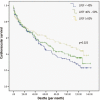Ten-Year Survival of Heart Failure Patients with Left Ventricular Ejection Fraction of 40-59%: A Potential Phenotypic Classification?
- PMID: 36790304
- PMCID: PMC10389085
- DOI: 10.36660/abc.20210772
Ten-Year Survival of Heart Failure Patients with Left Ventricular Ejection Fraction of 40-59%: A Potential Phenotypic Classification?
Abstract
Definitions of left ventricular ejection fraction (LVEF) cut-off values for HF with mildly reduced LVEF (HFmrEF) have been a subject of debate, in the face of evidence that some drugs used in the treatment of HF with LFEV < 40% (HFrEF) are also effective in patients with LVEF < 60%. The aim of this study was to compare overall survival and cardiovascular survival in HF patients with LVEF of 40-59% in patients with HFrEF and HF with LVEF ≥ 60%. Patients with decompensated HF who met the Framingham diagnostic criteria at hospital admission between 2009 and 2011 were included. Patients were divided into HFrEF, HF with LVEF 40-59%, and HF with LVEF ≥ 60%. The Kaplan-Meier was used to determine ten-year overall survival and cardiovascular survival. The statistical significance was established at p<0.05. A total of 400 patients were included, with a mean age of 69 ± 14 years. Cardiovascular survival in patients with HF and LVEF of 40-59% was not significantly different than in patients with HFrEF (adjusted Hazard Ratio [HR] 0.86; 95% Confidence Interval [CI] 0.61-1.22, Ptrend = NS), but was statistically different compared with patients with LVEF ≥ 60% (adjusted HR of 0.64; 95% CI 0.44-0.94, Ptrend = 0.023). No difference was found in 10-year survival between the LVEF groups. Patients with HF and LVEF ≥ 60% had significantly higher cardiovascular survival compared with the other groups.
Os limites da fração de ejeção do ventrículo esquerdo (FEVE) para a insuficiência cardíaca (IC) com FEVE levemente reduzida (ICFElr) têm sido questionados, já que evidências demonstram que alguns medicamentos utilizados para IC com FEVE <40% (ICFEr) demonstram eficácia também em populações com FEVE < 60%. Objetivo do estudo foi comparar a sobrevida total e cardiovascular de pacientes com IC com FEVE 40-59% com paciente com ICFEr e IC com FEVE ≥ 60%. Foram incluídos pacientes com IC descompensada que preencheram os critérios diagnósticos de Framingham na admissão hospitalar entre 2009 e 2011. Os pacientes foram divididos em ICFEr, IC com FEVE 40-59% e IC com FEVE ≥ 60%. O método de Kaplan-Meier foi usado para detectar a sobrevida geral e cardiovascular em 10 anos. A significância estatística foi estabelecida em p <0,05. Foram incluídos 400 pacientes, com idade média de 69 ± 14 anos. A sobrevida cardiovascular nos pacientes com IC e FEVE 40-59% não foi diferente em comparação aos pacientes com ICFEr [Hazard Ratio (HR) ajustado 0,86 – Intervalo de Confiança (IC) 95% 0,61-1,22; Ptrend = NS], mas foi estatisticamente diferente em comparação aos com FEVE ≥ 60% (HR ajustado = 0,64 - IC95% 0,44-0,94; Ptrend = 0,023). Não houve diferença na taxa de sobrevida de 10 anos entre diferentes grupos de FEVE. O grupo de pacientes com IC e FEVE ≥ 60% teve maior sobrevida cardiovascular que os outros grupos.
Conflict of interest statement
Potencial conflito de interesse
Não há conflito com o presente artigo
Figures




References
-
- Bozkurt B, Coats AJ, Tsutsui H, Abdelhamid M, Adamopoulos S, Albert N, et al. Universal Definition and Classification of Heart Failure: A Report of the Heart Failure Society of America, Heart Failure Association of the European Society of Cardiology, Japanese Heart Failure Society and Writing Committee of the Universal Definition of Heart Failure. J Card Fail. . 2021;(21):00050–00056. doi: 10.1016/j.cardfail.2021.01.022. S1071-9164. - DOI - PubMed
-
- Galderisi M, Cosyns B, Edvardsen T, Cardim N, Delgado V, Di Salvo G, et al. Standardization of Adult Transthoracic Echocardiography Reporting in Agreement with Recent Chamber Quantification, Diastolic Function, and Heart Valve Disease Recommendations: An Expert Consensus Document of the European Association of Cardiovascular Imaging. Eur Heart J Cardiovasc Imaging . 2017;18(12):1301–1310. doi: 10.1093/ehjci/jex244. - DOI - PubMed
Publication types
MeSH terms
LinkOut - more resources
Full Text Sources
Medical
Research Materials
Miscellaneous

